2012 SUBARU TRIBECA lock
[x] Cancel search: lockPage 43 of 420
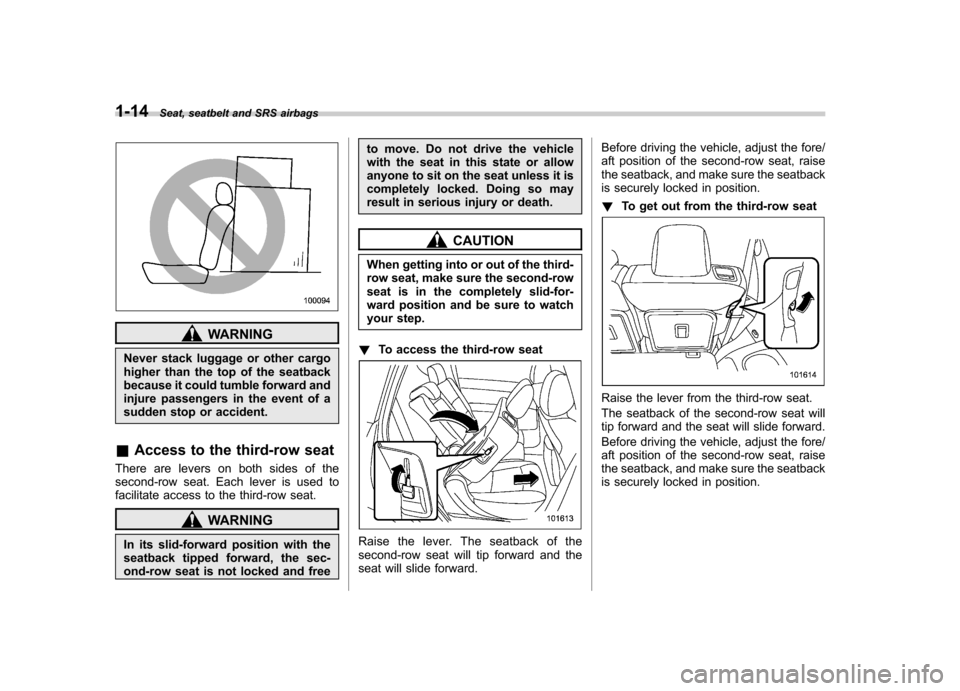
1-14Seat, seatbelt and SRS airbags
WARNING
Never stack luggage or other cargo
higher than the top of the seatback
because it could tumble forward and
injure passengers in the event of a
sudden stop or accident.
& Access to the third-row seat
There are levers on both sides of the
second-row seat. Each lever is used to
facilitate access to the third-row seat.
WARNING
In its slid-forward position with the
seatback tipped forward, the sec-
ond-row seat is not locked and free to move. Do not drive the vehicle
with the seat in this state or allow
anyone to sit on the seat unless it is
completely locked. Doing so may
result in serious injury or death.
CAUTION
When getting into or out of the third-
row seat, make sure the second-row
seat is in the completely slid-for-
ward position and be sure to watch
your step.
! To access the third-row seat
Raise the lever. The seatback of the
second-row seat will tip forward and the
seat will slide forward. Before driving the vehicle, adjust the fore/
aft position of the second-row seat, raise
the seatback, and make sure the seatback
is securely locked in position. !
To get out from the third-row seat
Raise the lever from the third-row seat.
The seatback of the second-row seat will
tip forward and the seat will slide forward.
Before driving the vehicle, adjust the fore/
aft position of the second-row seat, raise
the seatback, and make sure the seatback
is securely locked in position.
Page 44 of 420
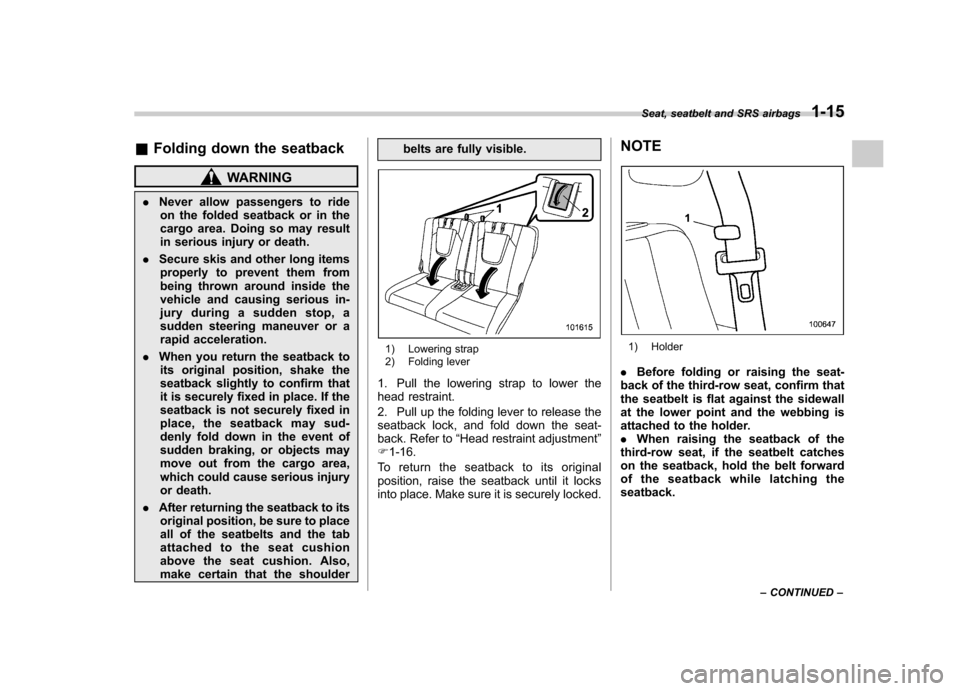
&Folding down the seatback
WARNING
. Never allow passengers to ride
on the folded seatback or in the
cargo area. Doing so may result
in serious injury or death.
. Secure skis and other long items
properly to prevent them from
being thrown around inside the
vehicle and causing serious in-
jury during a sudden stop, a
sudden steering maneuver or a
rapid acceleration.
. When you return the seatback to
its original position, shake the
seatback slightly to confirm that
it is securely fixed in place. If the
seatback is not securely fixed in
place, the seatback may sud-
denly fold down in the event of
sudden braking, or objects may
move out from the cargo area,
which could cause serious injury
or death.
. After returning the seatback to its
original position, be sure to place
all of the seatbelts and the tab
attached to the seat cushion
above the seat cushion. Also,
make certain that the shoulder belts are fully visible.
1) Lowering strap
2) Folding lever
1. Pull the lowering strap to lower the
head restraint.
2. Pull up the folding lever to release the
seatback lock, and fold down the seat-
back. Refer to “Head restraint adjustment ”
F 1-16.
To return the seatback to its original
position, raise the seatback until it locks
into place. Make sure it is securely locked. NOTE1) Holder
. Before folding or raising the seat-
back of the third-row seat, confirm that
the seatbelt is flat against the sidewall
at the lower point and the webbing is
attached to the holder.. When raising the seatback of the
third-row seat, if the seatbelt catches
on the seatback, hold the belt forward
of the seatback while latching theseatback. Seat, seatbelt and SRS airbags
1-15
– CONTINUED –
Page 47 of 420

1-18Seat, seatbelt and SRS airbags
the face or neck, adjust the shoulder belt
anchor height (window-side seating posi-
tions only) and then if necessary move the
child closer to the belt buckle to help
provide a good shoulder belt fit. Care must
be taken to securely place the lap belt as
low as possible on the hips and not on thechild’s waist. If the shoulder portion of the
belt cannot be properly positioned, a child
restraint system should be used. Never
place the shoulder belt under the child ’s
arm or behind the child ’s back.
! Expectant mothers
Expectant mothers also need to use the
seatbelts. They should consult their doctor
for specific recommendations. The lap belt
should be worn securely and as low as
possible over the hips, not over the waist. &
Emergency Locking Retrac-
tor (ELR)
The driver ’s seatbelt has an Emergency
Locking Retractor (ELR).
The emergency locking retractor allows
normal body movement but the retractor
locks automatically during a sudden stop,
impact or if you pull the belt very quickly
out of the retractor. & Automatic/Emergency Lock-
ing Retractor (A/ELR)
Each passenger ’s seatbelt has an Auto-
matic/Emergency Locking Retractor (A/
ELR). The Automatic/Emergency Locking
Retractor normally functions as an Emer-
gency Locking Retractor (ELR). The A/
ELR has an additional locking mode,“ Automatic Locking Retractor (ALR)
mode ”, intended to secure a child restraint
system.
The ALR mode functions as follows.
When the seatbelt is once drawn out
completely and is then retracted even
slightly, the retractor locks the seatbelt in
that position and the seatbelt cannot be
extended. As the belt is rewinding, clicks
will be heard which indicate the retractor
functions as an ALR. When the seatbelt is
retracted fully, the ALR mode is canceled
and the ELR mode is restored. When securing a child restraint system on
the rear passenger
’s seats by using a
seatbelt, the seatbelt must be changed
over to the Automatic Locking Retractor
(ALR) mode. For instructions on how to
install the child restraint system using a
seatbelt, refer to “Installing child restraint
systems with A/ELR seatbelt ”F 1-32.
When the child restraint system is re-
moved, make sure that the retractor is
restored to the Emergency Locking Re-
tractor (ELR) mode by allowing the seat-
belt to retract fully.
& Seatbelt warning light
and chime
Refer to “Seatbelt warning light and
chime ”F 3-10.
& Fastening the seatbelt
WARNING
. Never use a belt that is twisted or
reversed. In an accident, this can
increase the risk or severity of
injury.
. Keep the lap belt as low as
possible on your hips. In a colli-
sion, this spreads the force of the
lap belt over stronger hip bones
Page 48 of 420
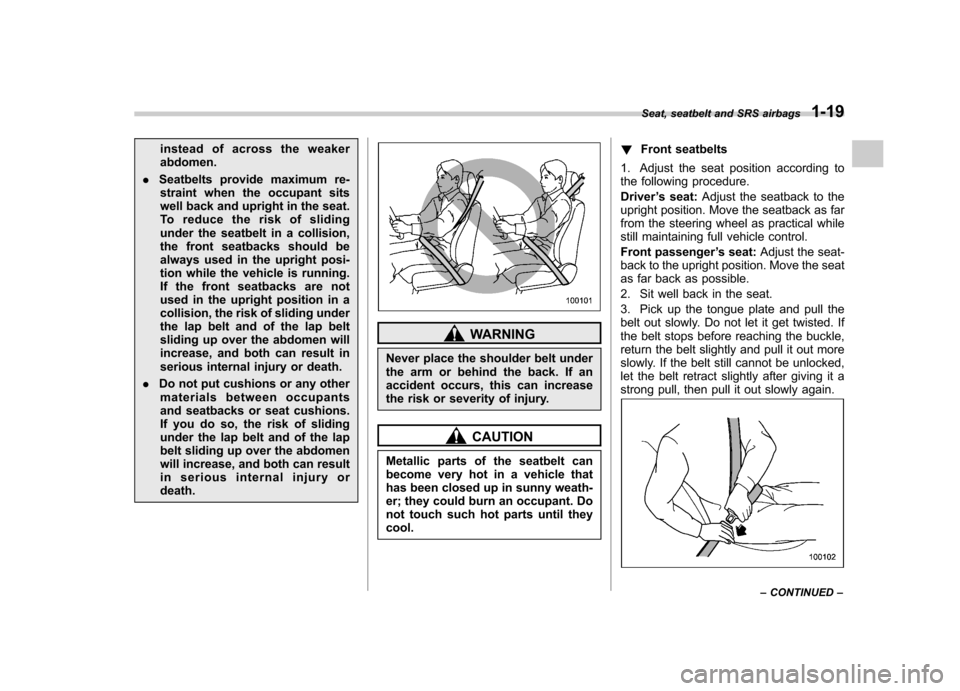
instead of across the weaker abdomen.
. Seatbelts provide maximum re-
straint when the occupant sits
well back and upright in the seat.
To reduce the risk of sliding
under the seatbelt in a collision,
the front seatbacks should be
always used in the upright posi-
tion while the vehicle is running.
If the front seatbacks are not
used in the upright position in a
collision, the risk of sliding under
the lap belt and of the lap belt
sliding up over the abdomen will
increase, and both can result in
serious internal injury or death.
. Do not put cushions or any other
materials between occupants
and seatbacks or seat cushions.
If you do so, the risk of sliding
under the lap belt and of the lap
belt sliding up over the abdomen
will increase, and both can result
in serious internal injury ordeath.
WARNING
Never place the shoulder belt under
the arm or behind the back. If an
accident occurs, this can increase
the risk or severity of injury.
CAUTION
Metallic parts of the seatbelt can
become very hot in a vehicle that
has been closed up in sunny weath-
er; they could burn an occupant. Do
not touch such hot parts until theycool. !
Front seatbelts
1. Adjust the seat position according to
the following procedure. Driver ’s seat: Adjust the seatback to the
upright position. Move the seatback as far
from the steering wheel as practical while
still maintaining full vehicle control.
Front passenger ’s seat: Adjust the seat-
back to the upright position. Move the seat
as far back as possible.
2. Sit well back in the seat.
3. Pick up the tongue plate and pull the
belt out slowly. Do not let it get twisted. If
the belt stops before reaching the buckle,
return the belt slightly and pull it out more
slowly. If the belt still cannot be unlocked,
let the belt retract slightly after giving it a
strong pull, then pull it out slowly again.
Seat, seatbelt and SRS airbags 1-19
– CONTINUED –
Page 49 of 420
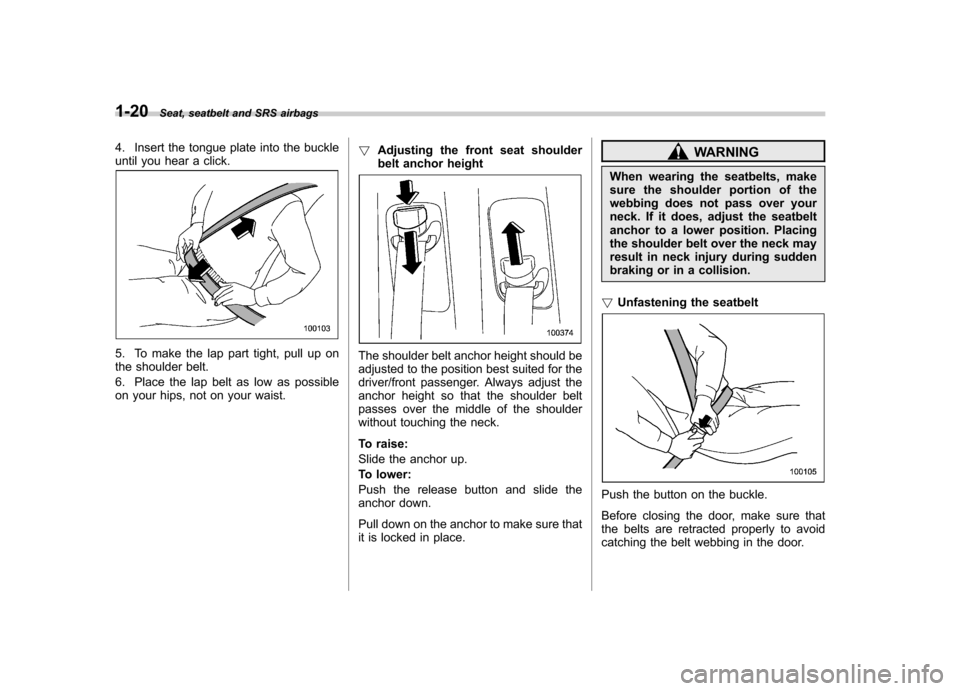
1-20Seat, seatbelt and SRS airbags
4. Insert the tongue plate into the buckle
until you hear a click.
5. To make the lap part tight, pull up on
the shoulder belt.
6. Place the lap belt as low as possible
on your hips, not on your waist. !
Adjusting the front seat shoulder
belt anchor heightThe shoulder belt anchor height should be
adjusted to the position best suited for the
driver/front passenger. Always adjust the
anchor height so that the shoulder belt
passes over the middle of the shoulder
without touching the neck.
To raise:
Slide the anchor up.
To lower:
Push the release button and slide the
anchor down.
Pull down on the anchor to make sure that
it is locked in place.
WARNING
When wearing the seatbelts, make
sure the shoulder portion of the
webbing does not pass over your
neck. If it does, adjust the seatbelt
anchor to a lower position. Placing
the shoulder belt over the neck may
result in neck injury during sudden
braking or in a collision.
! Unfastening the seatbelt
Push the button on the buckle.
Before closing the door, make sure that
the belts are retracted properly to avoid
catching the belt webbing in the door.
Page 50 of 420
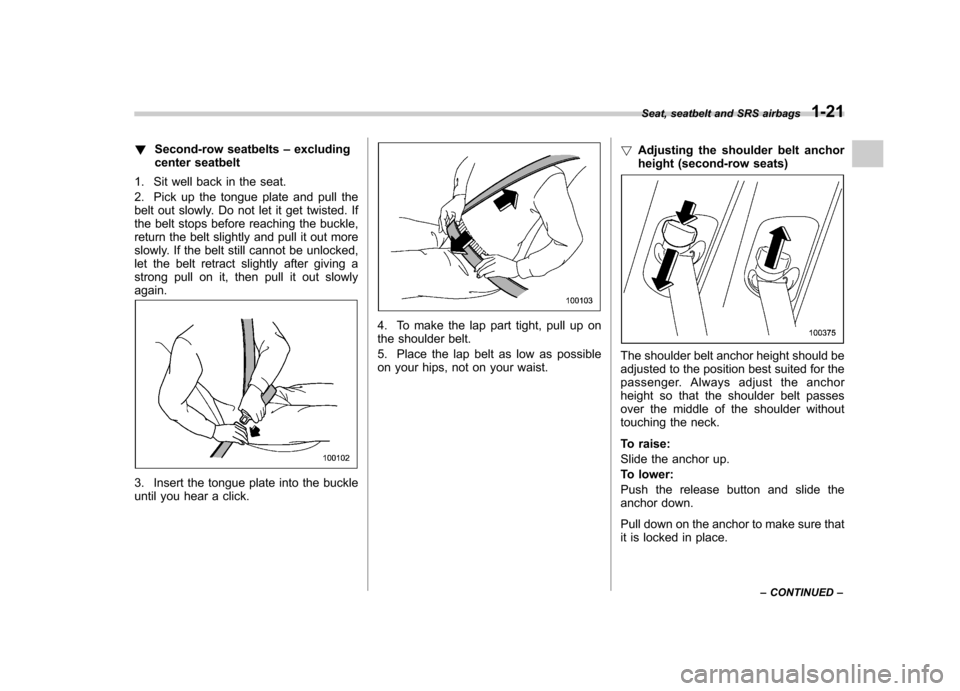
!Second-row seatbelts –excluding
center seatbelt
1. Sit well back in the seat.
2. Pick up the tongue plate and pull the
belt out slowly. Do not let it get twisted. If
the belt stops before reaching the buckle,
return the belt slightly and pull it out more
slowly. If the belt still cannot be unlocked,
let the belt retract slightly after giving a
strong pull on it, then pull it out slowlyagain.
3. Insert the tongue plate into the buckle
until you hear a click.
4. To make the lap part tight, pull up on
the shoulder belt.
5. Place the lap belt as low as possible
on your hips, not on your waist. !
Adjusting the shoulder belt anchor
height (second-row seats)
The shoulder belt anchor height should be
adjusted to the position best suited for the
passenger. Always adjust the anchor
height so that the shoulder belt passes
over the middle of the shoulder without
touching the neck.
To raise:
Slide the anchor up.
To lower:
Push the release button and slide the
anchor down.
Pull down on the anchor to make sure that
it is locked in place. Seat, seatbelt and SRS airbags
1-21
– CONTINUED –
Page 53 of 420
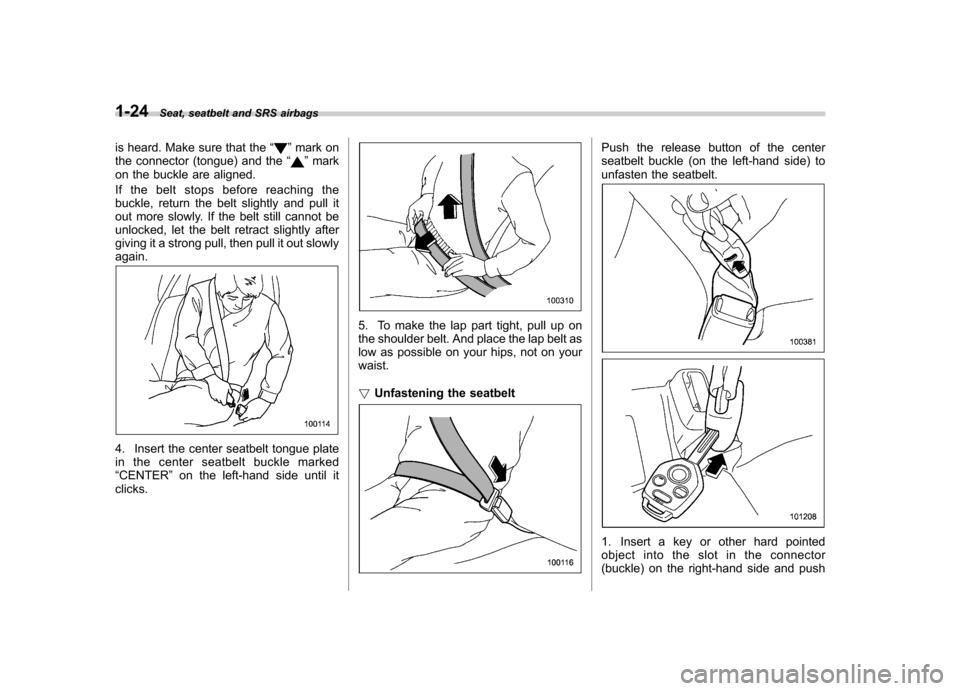
1-24Seat, seatbelt and SRS airbags
is heard. Make sure that the “
”mark on
the connector (tongue) and the “”mark
on the buckle are aligned.
If the belt stops before reaching the
buckle, return the belt slightly and pull it
out more slowly. If the belt still cannot be
unlocked, let the belt retract slightly after
giving it a strong pull, then pull it out slowlyagain.
4. Insert the center seatbelt tongue plate
in the center seatbelt buckle marked“ CENTER ”on the left-hand side until it
clicks.
5. To make the lap part tight, pull up on
the shoulder belt. And place the lap belt as
low as possible on your hips, not on yourwaist. ! Unfastening the seatbelt
Push the release button of the center
seatbelt buckle (on the left-hand side) to
unfasten the seatbelt.
1. Insert a key or other hard pointed
object into the slot in the connector
(buckle) on the right-hand side and push
Page 54 of 420
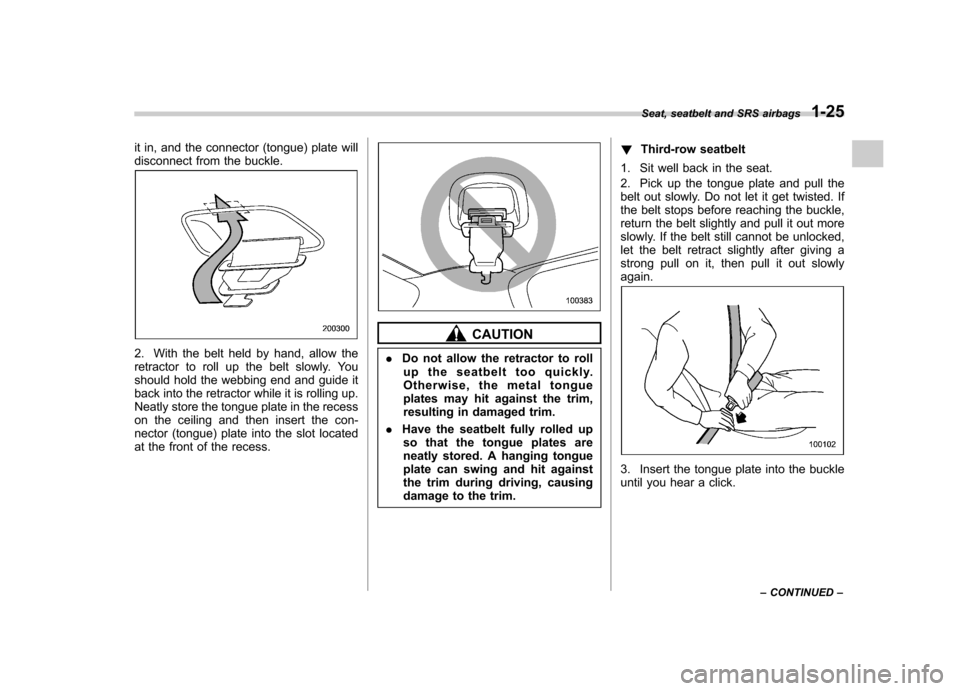
it in, and the connector (tongue) plate will
disconnect from the buckle.
2. With the belt held by hand, allow the
retractor to roll up the belt slowly. You
should hold the webbing end and guide it
back into the retractor while it is rolling up.
Neatly store the tongue plate in the recess
on the ceiling and then insert the con-
nector (tongue) plate into the slot located
at the front of the recess.
CAUTION
. Do not allow the retractor to roll
up the seatbelt too quickly.
Otherwise, the metal tongue
plates may hit against the trim,
resulting in damaged trim.
. Have the seatbelt fully rolled up
so that the tongue plates are
neatly stored. A hanging tongue
plate can swing and hit against
the trim during driving, causing
damage to the trim. !
Third-row seatbelt
1. Sit well back in the seat.
2. Pick up the tongue plate and pull the
belt out slowly. Do not let it get twisted. If
the belt stops before reaching the buckle,
return the belt slightly and pull it out more
slowly. If the belt still cannot be unlocked,
let the belt retract slightly after giving a
strong pull on it, then pull it out slowlyagain.
3. Insert the tongue plate into the buckle
until you hear a click. Seat, seatbelt and SRS airbags
1-25
– CONTINUED –